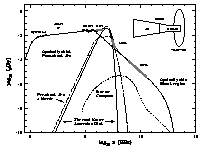
A jet model for the broadband spectrum of XTE J1118+480: Synchrotron emission from radio to X-rays in the Low/Hard spectral state
Sera Markoff1, Heino Falcke1, Rob Fender2
1Max-Planck-Institut für Radioastronomie, Auf den Hügel 69, D-53121 Bonn, Germany (hfalcke,smarkoff@mpifr-bonn.mpg.de)2Astronomical Institute ``Anton Pannekoek'', University of Amsterdam, Netherlands
Astronomy & Astrophysics Letters, Vol. 372, L25 (2001)
Abstract:
Observations have revealed strong evidence for powerful jets in the Low/Hard states of black hole candidate X-ray binaries. Correlations, both temporal and spectral, between the radio -- infrared and X-ray bands suggest that jet synchrotron as well as inverse Compton emission could also be significantly contributing at higher frequencies. We show here that, for reasonable assumptions about the jet physical parameters, the broadband spectrum from radio through X-rays can be almost entirely fit by synchrotron emission. We explore a relatively simple model for a relativistic, adiabatically expanding jet combined with a truncated thermal disk conjoined by an ADAF, in the context of the recently discovered black hole binary XTE J1118+480. In particular, the X-ray power-law emission can be explained as optically thin synchrotron emission from a shock acceleration region in the innermost part of the jet, with a cutoff determined by cooling losses. For synchrotron cooling-limited particle acceleration, the spectral cutoff is a function only of dimensionless plasma parameters and thus should be around a ``canonical'' value for sources with similar plasma properties. It is therefore possible that non-thermal jet emission is important for XTE J1118+480 and possibly other X-ray binaries in the Low/Hard state.
Paper: Available in PostScript and LaTex. Please send an email request to hfalcke@mpifr-bonn.mpg.de for a preprint.
Other publications can be found here.
Questions: Heino Falcke, hfalcke@mpifr-bonn.mpg.de